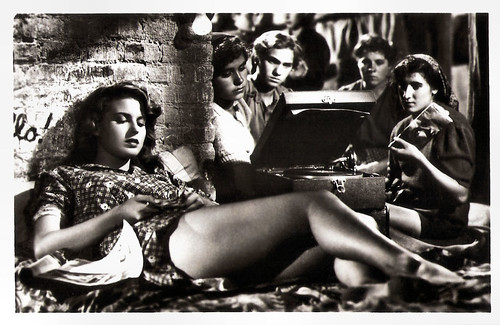
Dutch postcard by Centrafilm, Dordrecht. Silvana Mangano in Riso amaro/Bitter Rice (Giuseppe de Santis, 1949). Collection: Geoffrey Donaldson Instituut.
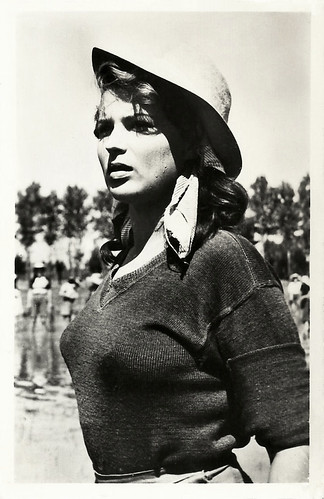
Dutch postcard by Filmverhuurkantoor Centrafilm, Dordrecht. Silvana Mangano in Riso amaro/Bitter Rice (Giuseppe de Santis, 1949).

Dutch postcard by DRC, no. F 196. Photo: Lux Film.
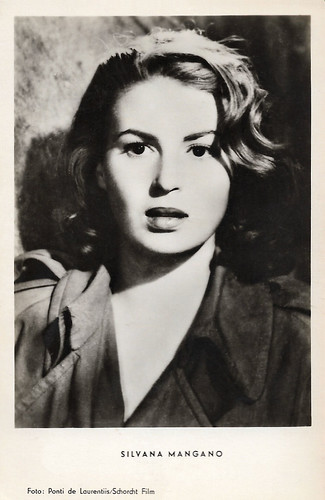
West-German postcard by Kunst und Bild, Berlin, no. A 737. Photo: Ponti De Laurentiis / Schorchtfilm. Silvana Mangano in Anna (Alberto Lattuada, 1951).

West-German postcard by Kolibri-Verlag, no. 651. Photo: Lux-Schorchtfilm. Silvana Mangano in Anna (Alberto Lattuada, 1951).

Italian postcard by Bromostampa, Milano (Milan), no. 37. Silvana Mangano in Ulisse/Ulysses (Mario Camerini, 1954), produced by Silvana's husband, Dino De Laurentiis.
Shocking Hotpants
Silvana Mangano was born in Rome in 1930 to an Italian father, a Sicilian train conductor, and an English mother. Her brother was sound technician Roy Mangano and her sisters are one-time actresses Patrizia Mangano and Natascia Mangano. Silvana grew up in poverty caused by the Second World War.
Trained for seven years as a dancer by Zhia Ruskaya, she was supporting herself as a model. At 16, she won the Miss Rome beauty contest in 1946 and got a small role in the opera adaptation L'Elisir d'amore/Elixir of Love (Mario Costa, 1948) with Tito Gobbi. She was also nominated for the Miss Italia contest in 1947, which Lucia Bosé won.
Mangano's earliest connection with filmmaking occurred through her romantic relationship with actor Marcello Mastroianni. Mangano started to play small roles in films like Il delitto di Giovanni Episcopo/Flesh Will Surrender (Alberto Lattuada, 1947), Gli uomini sono nemici/Crossroads of Passion (1948, Ettore Giannini) with French diva Viviane Romance, and Black Magic (Gregory Ratoff, 1949) starring Orson Welles.
She had her breakthrough with the neo-realistic crime story Riso amaro/Bitter Rice (Giuseppe De Santis, 1949), situated in the rice fields along the Po river in Northern Italy. Mangano played the voluptuous rice picker Silvana, who falls for the criminal Walter (Vittorio Gassman) and his presumed wealth.
The thousands of female rice workers, up to their ankles in the water, breaking their backs in the burning sun to earn a few bucks, make an impressive decor. To the standards of 1949s Roman Catholic Italy Mangano's performance in hotpants was shocking. This earned Riso Amaro a lot of publicity and earned Mangano a contract with the Lux company.

Spanish postcard, 1953. Photo: Lux Films / Rey Soria. Silvana Mangano in Riso Amaro/Bitter Rice (Giuseppe De Santis, 1949).

Belgian card offered by Nieuwe Merksemsche Chocolaterie SPRL, Merksem (Antwerp). Photo: Lux- Film, Roma. Silvana Mangano as the rice picker Silvana in Riso amaro/ Bitter Rice (Giuseppe De Santis, 1949), released in Flanders and the Netherlands as Bittere Rijst.

Belgian postcard by Nieuwe Merksemsche Chocolaterie, Merksem. Photo: Lux Film Rome. Silvana Mangano in Riso Amaro/Bitter Rice (1949).

Belgian collectors card by Fotoprim, Brussels, for De Beukelaer, Antwerp, no A 15. Photo: Lux Film. Silvana Mangano in Riso Amaro/Bitter Rice (Giuseppe De Santis, 1949).

Italian postcard by Rotalfoto, Milano, no. 130. Photo: Ponti - De Laurentiis. Silvana Mangano in Anna (Alberto Lattuada, 1951).
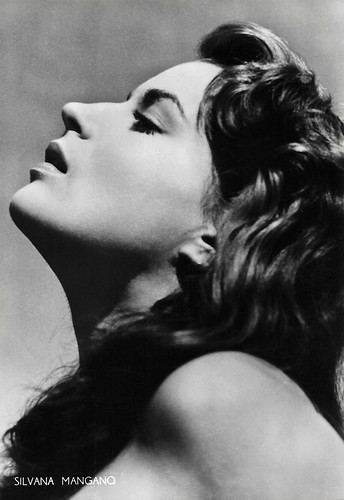
Italian postcard by Bromostampa, Milano, no. 354.
Pig-fancying Enchantress
Though Silvana Mangano never scaled the heights of her competitors Sophia Loren and Gina Lollobrigida, she was a popular European film star in the 1950s and 1960s.
Lux produced her subsequent films such as Anna (Alberto Lattuada, 1951) with Raf Vallone, and Ulisse/Ulysses (Mario Camerini, 1954), an adaptation of Homer's second epic featuring Kirk Douglas. Mangano played both Ulysses' faithful wife Penelope and the pig-fancying enchantress Circe.
In 1949, she had married producer Dino De Laurentiis who controlled her career and launched her as the leading lady of international co-productions such as Mambo (Robert Rossen, 1954) with Michael Rennie, This Angry Age/Le barrage sur le Pacifique (René Clément, 1958) with Anthony Perkins, and 5 Branded Woman/Jovanka e le altre (Martin Ritt, 1960) with Jeanne Moreau.

Italian postcard by Bromofoto, Milano, no. 275.

Dutch postcard by Takken / 't Sticht, no. 822. Photo: Standaardfilm / Lux. Silvana Mangano in Anna (Alberto Lattuada, 1951).
Dutch postcard, no. 34. Photo: Standard-Films. Silvana Mangano as Circe/Penelope in Ulisse/Ulysses (1954).
Italian postcard by Rotalfoto, Milano (Milan), no. 230.

Dutch postcard, no. 857. Photo: Luxardo.
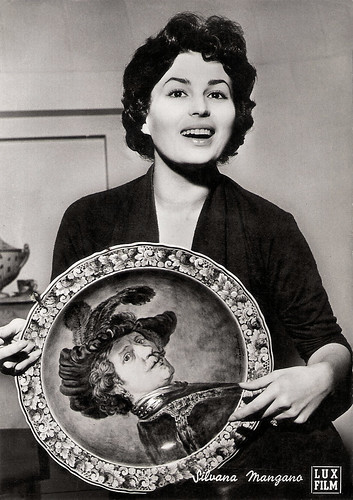
Italian postcard by Bromofoto, Milano. Photo: Lux Film. Mangano holds up a kitschy copy of a man's portrait (ca. 1635) by Dutch painter Rembrandt van Rijn, now at the Mauritshuis at the Hague.
Visconti and Pasolini
In 1967, Silvana Mangano starred in the anthology film Le streghe/The Witches (1967). The five episodes were directed by Mauro Bolognini, Vittorio De Sica, Pier Paolo Pasolini, Franco Rossi and Luchino Visconti.
Visconti shot the quite cynical and biographical episode La strega bruciata viva/The Witch Burned Alive, and he later cast her again as Tadzio's (Björn Andrésen) aristocratic mother in Morte a Venezia/Death in Venice (Luchino Visconti, 1971), modeled on Visconti's own mother.
She also played the cunning Cosima von Bülow in Ludwig (Luchino Visconti, 1972), and the hysterical marchesa Brumonti in Gruppo di famiglia in un interno/Conversation Piece (Luchino Visconti, 1974) opposite Burt Lancaster.
Mangano also performed in three films by Pasolini: as Jocaste in Edipo re/Oedipus Rex (Pier Paolo Pasolini, 1967), an updated version of the Greek tragedy by Sophocles; as Lucia, the mother in Teorema/Theorem (Pier Paolo Pasolini, 1968) with Terence Stamp, and as the Holy Virgin - a small, uncredited role - in Il Decameron/The Decameron (Pier Paolo Pasolini, 1971).
French postcard by Editions P.I., no. 159.
French postcard by Editions P.I., Paris, offered by Les Carbones Korès, no. 618.
French postcard by Editions P.I., Paris, no. 743.

Italian postcard by B.F.F. Edit., no. 3044. Photo: Ponti-De Laurentiis / Paramount. Silvana Mangano in Mambo (Robert Rossen, 1954).

Italian postcard by Turismofoto, no. 8. Silvana Mangano in This Angry Age (René Clément, 1957).

West-German postcard. Photo: G.B. Poletto / Ufa. Silvana Mangano in La tempesta/Tempest (Alberto Lattuada, 1958).
Tapestries
In the 1980s, Silvana Mangano's life took a bad turn. In 1981 her son, Federico De Laurentiis was killed in an Alaskan air crash.
In 1983 she separated from Dino De Laurentiis, though they did not divorce. She dedicated her time to making tapestries, alternating her domicile between Madrid and Paris.
She did not perform in films anymore, except for Dune (David Lynch, 1984) and Oci ciornie/Dark Eyes (Nikita Mikhalkov, 1987), in which she played Romano's (Marcello Mastroianni) wife. Mangano began divorce proceedings in 1988.
Silvana Mangano, who had always been a strong smoker, died of lung cancer in 1989, in a hospital in Madrid. She was only 59. Silvana Mangano had four children with Dino De Laurentiis: Veronica, Raffaella, Francesca, and the deceased Federico.
Veronica's daughter Giada De Laurentiis is the host of Everyday Italian and Giada at Home on the Food Network. Raffaella coproduced with her father on Mangano's penultimate film, Dune (1984). Following her death, she was interred at Pawling Cemetery in Pawling, Dutchess County, New York.
Italian postcard by Bromostampa, Milano in the series 'Hobby'.
Italian postcard by Ferrania. Photo: Dino De Laurentiis Cinematografica.
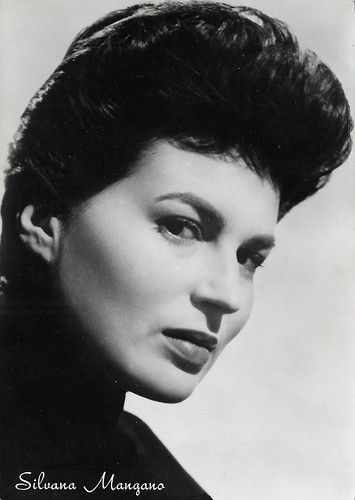
Italian postcard by Rotalfoto, Milano, no. 101. Photo: Ponti-De Laurentiis.

Italian postcard by Rotalfoto, Milano, no. 840. Might perhaps have been for the episode La strega bruciata viva by Luchino Visconti in the episode film Le streghe (1967).
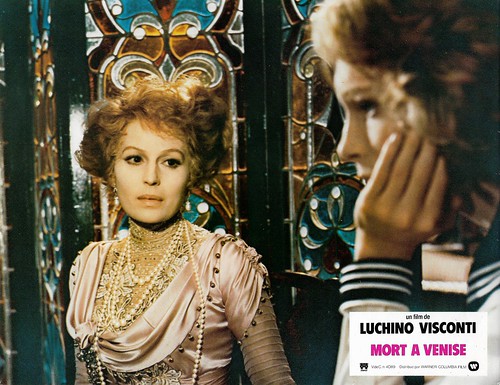
French publicity leaflet. Silvana Mangano and Björn Andresen in Death in Venice/Morte a Venezia/Mort à Venise (Luchino Visconti, 1971), starring Dirk Bogarde. Dress designed by Piero Tosi.
Scene from Riso amaro/Bitter Rice (1949). Source: boct2007 (YouTube).
Scene from Anna (1951). Although it was sung by Flo Sandon, Silvana Mangano was credited on the record label of 'El Negro Zumbón'. Source: jack11anbar (YouTube).
Sources: Hal Erickson (AllMovie), Wikipedia, and IMDb.
This post was last updated on 26 June 2021.
No comments:
Post a Comment